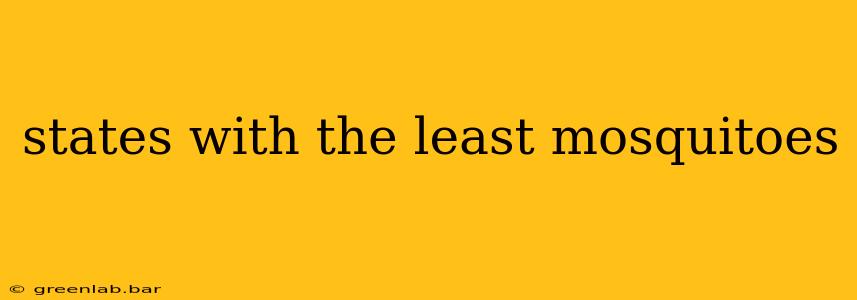Mosquitoes. The tiny, buzzing vampires of summer. They're a nuisance at best, and a serious health concern at worst. If you're tired of swatting, itching, and worrying about diseases like West Nile virus, you're probably dreaming of a mosquito-free vacation or even a permanent move to a lower-mosquito-density region. But which states boast the fewest of these pesky insects? Let's dive in.
It's important to preface this by stating that no state is entirely mosquito-free. Mosquito populations fluctuate based on weather patterns, rainfall, and even human activity. However, some states consistently report lower mosquito populations than others due to a combination of factors like climate, geography, and implemented control measures.
Factors Influencing Mosquito Populations
Before we list the states, let's understand what makes a state less attractive to mosquitoes:
- Climate: Hot, humid climates are ideal breeding grounds. Dry, arid regions tend to have fewer mosquitoes.
- Rainfall: Standing water is essential for mosquito breeding. Areas with less rainfall generally have lower mosquito populations.
- Altitude: Higher elevations often mean lower temperatures and fewer breeding sites.
- Vegetation: Dense vegetation provides hiding places for both adult mosquitoes and their larvae. Open, less vegetated areas tend to have fewer mosquitoes.
- Public Health Initiatives: States with robust mosquito control programs (including larvicide application and public education) can significantly impact populations.
States Generally Considered to Have Fewer Mosquitoes
While definitive rankings are difficult due to fluctuating populations and varying reporting methods, these states frequently appear on lists of places with lower mosquito activity:
1. States in the Mountain West:
- Nevada: Much of Nevada's landscape is desert, providing fewer breeding sites for mosquitoes. The dry climate isn't ideal for mosquito reproduction.
- Arizona: Similar to Nevada, Arizona's arid climate and high desert terrain significantly limit mosquito breeding.
- Utah: The high altitude and drier climate of much of Utah contribute to lower mosquito populations. However, localized areas near water sources may have higher numbers.
- Idaho: While parts of Idaho have higher humidity, much of the state experiences a drier climate that is less hospitable to mosquitoes.
2. States with Less Humidity and Rainfall:
- New Mexico: The arid southwestern climate of New Mexico tends to limit mosquito populations compared to more humid states.
- Wyoming: Wyoming's high altitude and lower humidity result in a less mosquito-prone environment.
3. Coastal States with Specific Microclimates:
- Parts of California: While California has diverse climates, coastal areas with less rainfall and milder temperatures often experience lower mosquito populations than inland areas.
Important Note: Even in these states, mosquito activity can vary regionally. Areas near bodies of water, such as lakes and marshes, will generally have higher populations than drier, higher-elevation regions.
Protecting Yourself from Mosquitoes, Regardless of Location
Even in states with lower mosquito populations, taking precautions is vital. Remember to:
- Use insect repellent: Choose a repellent containing DEET, picaridin, IR3535, or oil of lemon eucalyptus.
- Wear long sleeves and pants: Cover exposed skin, especially during dawn and dusk when mosquitoes are most active.
- Eliminate standing water: Get rid of any stagnant water around your home, such as in flower pots, birdbaths, or clogged gutters.
By understanding the factors that influence mosquito populations and taking appropriate precautions, you can significantly reduce your risk of mosquito bites, no matter where you live or travel. Enjoy a more peaceful and bite-free summer!

